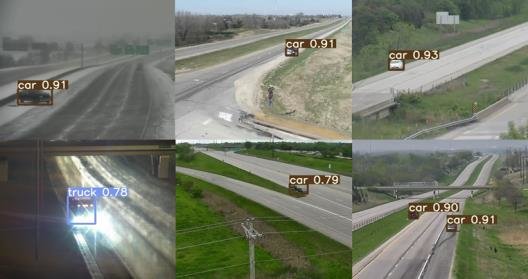Research
Traffic Anomaly Detection
In this project, we developed a framework for detecting traffic anomalies in video data. The proposed methodology relies on an augmented annotation pipeline that pre-annotates the training dataset using an object detection model trained on the COCO dataset. Annotations are subsequently used to build a vehicle detection model using the YOLOv5 network. Next, we estimate the background of each traffic video by computing the median of frames randomly sampled from a uniform distribution over a thirty-second period. Vehicle detections on extracted backgrounds are classified as anomaly candidates. Factors such as vehicle detection size, likelihood, and road feature masks were used to construct a decision tree to eliminate false anomalies. The start and end of an anomaly were computed by superimposing detections from anomaly candidates and their foreground detections. The main contributions are as follows
- Developed a fast and efficient data annotation pipeline
- Developed decision-tree based method for anomaly detection
- Developed a real-time model for traffic anomaly detections

Traffic Signal Performance Evaluation for Vulnerable Road Users
This project has 2 main objectives: 1) to categorize pedestrians into subcategories in order to address their safety requirements at intersections; 2) to estimate the time required to cross an intersection and determine whether the pedestrian can safely cross within the pedestrian signal time allotted at intersections. The objectives were accomplished using data collected from three Ouster digital LiDAR sensors installed at an intersection in Chattanooga, Tennessee. The data was collected over a period of 3 hours. The datasets contain pedestrian and signal phase data. The LiDAR dataset included information about the physical characteristics of pedestrians such as their speeds, positions, directions, and size. The study defined heuristics to subclassify the pedestrian and evaluated the accuracy of the sub-classification using machine learning models. The study also carried analysis to determine if pedestrians were able to cross the intersection or not during the pedestrian allocated time.

DeepSegmenter: Temporal Action Localization for Detecting Anomalies in Untrimmed Naturalistic Driving Videos
Identifying unusual driving behaviors exhibited by drivers during driving is essential for understanding driver behavior and the underlying causes of crashes. Previous studies have primarily approached this problem as a classification task, assuming that naturalistic driving videos come discretized. However, both activity segmentation and classification are required for this task due to the continuous nature of naturalistic driving videos. The current study therefore departs from conventional approaches and introduces a novel methodological framework, DeepSegmenter, that simultaneously performs activity segmentation and classification in a single framework. The proposed framework consists of four major modules namely Data Module, Activity Segmentation Module, Classification Module and Postprocessing Module. Our proposed method won 8th place in the 2023 AI City Challenge, Track 3, with an activity overlap score of 0.5426 on experimental validation data. The experimental results demonstrate the effectiveness, efficiency, and robustness of the proposed system.

Real-time Multi-Class Helmet Violation Detection Using Few-Shot Data Sampling Technique and YOLOv8
Traffic safety is a major global concern. Helmet usage is a key factor in preventing head injuries and fatalities caused by motorcycle accidents. However, helmet usage violations continue to be a significant problem. To identify such violations, automatic helmet detection systems have been proposed and implemented using computer vision techniques. Real-time implementation of such systems is crucial for traffic surveillance and enforcement, however, most of these systems are not real-time. This study proposes a robust real-time helmet violation detection system. The proposed system utilizes a unique data processing strategy, referred to as few-shot data sampling, to develop a robust model with fewer annotations, and a single-stage object detection model, YOLOv8 (You Only Look Once Version 8), for detecting helmet violations in real-time from video frames. Our proposed method won 7th place in the 2023 AI City Challenge, Track 5, with an mAP score of 0.5861 on experimental validation data. The experimental results demonstrate the effectiveness, efficiency, and robustness of the proposed system.

An in silico Driver Maneuver Detection
The current paper implements a methodology for automatically detecting vehicle maneuvers from vehicle telemetry data under naturalistic driving settings. Previous approaches have treated vehicle maneuver detection as a classification problem, although both time series segmentation and classification are required since input telemetry data is continuous. Our objective is to develop an end-to-end pipeline for frame-by-frame annotation of naturalistic driving studies videos into various driving events including stop and lane keeping events, lane changes, left-right turning movements, and horizontal curve maneuvers. To address the time series segmentation problem, the study developed an Energy Maximization Algorithm (EMA) capable of extracting driving events of varying durations and frequencies from continuous signal data. To reduce overfitting and false alarm rates, heuristic algorithms were used to classify events with highly variable patterns such as stops and lanekeeping. To classify segmented driving events, four machine learning models were implemented, and their accuracy and transferability were assessed over multiple data sources. The duration of events extracted by EMA were comparable to actual events, with accuracies ranging from 59.30% (left lane change) to 85.60% (lane-keeping). Additionally, the overall accuracy of the 1D-convolutional neural network model was 98.99%, followed by the Long-short-termmemory model at 97.75%, then random forest model at 97.71%, and the support vector machine model at 97.65%. These model accuracies where consistent across different data sources. The study concludes that implementing a segmentation-classification pipeline significantly improves both the accuracy for driver maneuver detection and transferability of shallow and deep ML models across diverse datasets.
- Developed a fast and efficient data annotation pipeline
- Developed decision-tree based method for anomaly detection
- Developed a real-time model for traffic anomaly detections

Pavement Roughness Estimation
The primary objective of this project was to develop a model to quickly and accurately determine the IRI values of road sections at a cheaper cost. In this project, I developed a smartphone app to collect road surface data at a cheaper cost. Also, I utilized other variables such as speed and gyroscope information in addition to the vertical acceleration information to increase the accuracy of determining IRI values of road sections.

